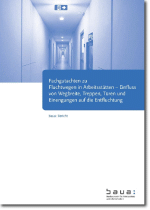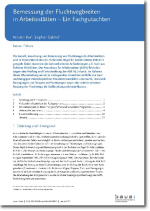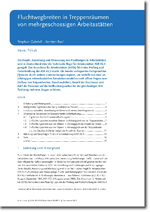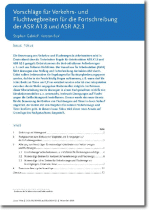An expert report analyses how pathway widths and constrictions, and the time-staggered use of escape routes influence escape times.
Technical Rule for Workplaces (Arbeitsstättenregel) ASR A2.3, which was updated by the Committee for Workplaces (Ausschuss für Arbeitsstätten, ASTA) in 2022, defines requirements regarding the dimensions of escape routes. An expert report was drawn up, in which the impact of constrictions and stairs along escape routes and the time-staggered use of escape routes on escape times were investigated using a number of simulation models.
Employers are required to take precautions for employees’ protection when setting up and operating workplaces in order to ensure their staff can be brought to safety immediately and rescued quickly in case of danger (Section 4(4) Ordinance on Workplaces (Arbeitsstättenverordnung, ArbStättV)). The configuration of escape routes and emergency exits plays an important role in this context. The required number, arrangement, and dimensions of escape routes have been stipulated for this purpose in Technical Rule for Workplaces ASR A2.3, Escape Routes and Emergency Exits (Fluchtwege und Notausgänge). Some of the requirements included in ASR A2.3 had been taken over from earlier guildelines. The Committee for Workplaces therefore commissioned a project group with reviewing and updating the rule. The new version of ASR A2.3, fully revised to take account of the latest technological developments, was published in the Joint Ministerial Gazette (Gemeinsames Ministerialblatt, GMBl.) in March 2022.
To support the revision of this document, an expert report was commissioned by the Federal Institute for Occupational Safety and Health (Bundesanstalt für Arbeitsschutz und Arbeitsmedizin, BAuA) to investigate the extent to which the width of pathways, stairs, doors, and constrictions influences escape times and what effects the staggered use of escape routes has in multistorey buildings. The interactions between the number of levels (storeys, floors), the number of people per level, and the width of the stairs were analysed in a supplementary study. The expert report is based on calculations carried out using two independent microscopic simulation models, as well as comparative calculations carried out using macroscopic flow models.
One of the results of this investigation was that short constrictions on horizontal escape routes barely have any impact on the total escape time or the passage time of individual persons. In contrast, longer constrictions on horizontal escape routes that may be encountered in real-world scenarios due to furniture in corridors can have a significant influence on escape times. This causes delays in the evacuation of buildings. The analyses also showed the existence of a constant linear correlation between the width of the escape route and the total escape time. Stairs along escape routes lead to a marked deceleration in the passage of people. If an escape route consists of horizontal as well as vertical elements (stairs), any constrictions along the corridor, including a compliant door leading to the stairwell, have negligible effects because it is actually the stairs that cause the passage of people to slow down. As of a certain degree of occupancy on the levels of multistorey buildings, tailbacks can occur in stairwells and the adjoining areas of each level.
The results are comprehensively presented in a baua: Report. Two editions of baua: Focus summarise the results and explain individual topics. The results of the expert report have been used to adapt the regulations regarding the widths of escape routes in ASR A2.3 to the state of the art.



